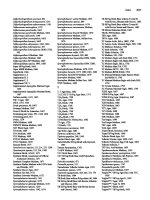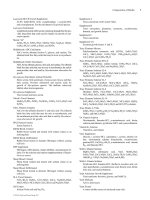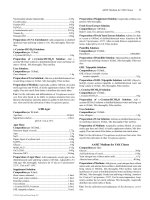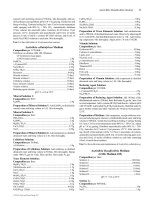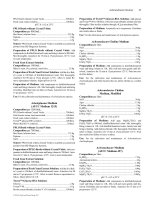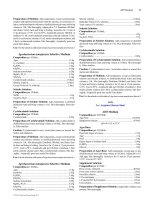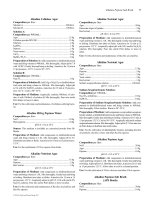Acute care handbook for physical therapists (fourth edition) chapter 2 the medical record
Bạn đang xem bản rút gọn của tài liệu. Xem và tải ngay bản đầy đủ của tài liệu tại đây (160.13 KB, 4 trang )
CHAPTER
2
The Medical Record
Michele P. West
CHAPTER OUTLINE
CHAPTER OBJECTIVES
Confidentiality
Physical Therapist
Documentation
Physical Therapy Considerations
Components of the Medical
Record
Orders
Admission Note Format
Progress Notes
Reports
The objectives for this chapter are the following:
1. Briefly describe the medical record in paper and electronic forms, including medical record confidentiality
and security
2. Review documentation standards for the physical therapist and physical therapist assistant
3. Describe the different components of the medical record, including a detailed outline of the admission
history and physical
PREFERRED PRACTICE PATTERNS
The medical record is multifactorial and applies to many body systems. For this reason, specific
practice patterns are not delineated in this chapter. Please refer to Appendix A for a complete
list of the preferred practice patterns to identify the most applicable practice pattern for a
given diagnosis.
The medical record, whether paper or electronic, is a legal document that chronicles a patient’s
clinical course during hospitalization and is the primary means of communication between
the various clinicians caring for a single patient. More specifically, the medical record contains
information about past or present symptoms and disease(s), test and examination results,
interventions, and the medical-surgical outcome.1 Additionally, the medical record may be
used for educational purposes and for performing quality improvement studies, conducting
research, and resolving legal issues such as competency or disability.2
The widespread use of electronic health records (EHR) has been promoted by the Health
Information Technology for Economic and Clinical Health (HITECH) Act, which consists of
three-stage criteria, including financial incentives for hospitals to comply with an EHR. Stage
1 calls for EHR compliance by the end of 2014, with penalties for those institutions or providers not in compliance.3 Stages 2 and 3 are yet to be specifically defined. In conjunction
with the transition to EHR, an initiative known as “meaningful use” has been developed to
ensure providers are able to enhance the quality of patient care with the implementation
of EHR.4
Specific advantages of an EHR compared with a paper record include complete and accurate
patient health data that is readily available and shared with multiple providers to improve
care coordination, the convenience of electronic prescriptions, the ability to track quality data,
patient empowerment (by giving them access to their own records), and the potential for
improved automatic patient follow-up.5
Confidentiality
According to the Health Insurance Portability and Accountability Act (HIPAA) Privacy Rule,
any information in the medical record that contains “protected health information (PHI)”
should be kept confidential, and all health care providers should safeguard the availability and
integrity of health care information in oral, written, or electronic forms.6 PHI includes any
information that pertains to the past, present, or future physical or mental health conditions
of an individual, including provision of care, payment of care, and demographics.7 A subset
of the Privacy Rule is the Security Rule, which specifically addresses the confidentiality of electronic PHI (e-PHI). The Security Rule states that a covered entity must ensure the integrity
11
12
CHAPTER 2 The Medical Record
and availability of e-PHI that it creates, maintains, or transmits.8 The goal of the Security Rule is to protect e-PHI as institutions such as hospitals adopt new and efficient technologies.8
Specific topics, such as human immunodeficiency virus status,
substance abuse, domestic abuse, or psychiatric history, are
privileged information, and discussion of them is subject to
additional ethical and regulatory guidelines.9
The physical therapist must be compliant with HIPAA,10
the American Physical Therapy Association’s Guide for Professional Conduct and Code of Ethics for Physical Therapists,11,11a and
any policies and procedures of the facility or state in regard to
sharing medical record information with the patient, family,
caretakers, visitors, or third parties.
CLINICAL TIP
To ensure confidentiality of PHI in the acute care setting, the
physical therapist should log off the computer when not in use,
keep the written medical chart and flow books closed when not
in use, cover any paperwork kept on clipboards when traveling
in the facility, and use discretion when discussing patient information in shared rooms, hallways, and/or elevators.
Physical Therapist Documentation
The physical therapist should comply with the documentation
standards including, but not limited to, the policies/procedures
of the organization, the state, and the American Physical
Therapy Association’s Guidelines for Physical Therapy Documentation of Patient/Client Management.12
In general, documentation must be:
• Dated and timed with an authenticated signature, including
therapist credentials
• Legible and in black ink (in a paper chart)
• Clearly labeled with the appropriate patient identification
• Complete, accurate, and objective
• Cosigned for a physical therapist assistant or student
therapist
Documentation should be free of ambiguous acronyms or
abbreviations to minimize misinterpretation and prevent errors
that could result in patient safety issues (Table 2-1).13
These standards apply to the examination, evaluation, and
plan of care portions of physical therapist documentation,
including flow sheets. A documentation entry is required for
every physical therapist visit and should include the following,
if applicable14:
• Phone calls or conversations with other health care
providers
• Handouts provided to the patient, including exercise programs or educational materials
• The use of interpreter services
• Therapist response and assessment of an adverse event or
situation
Ideally, documentation of physical therapy intervention
should occur at point of service or as close to the time of
intervention as possible. If a documentation error is noted,
correct the error as soon as possible. Be familiar with your
institution’s policy for correcting chart errors in written or
electronic formats.
Physical Therapy Considerations
• Be sure to document when a patient/family member declines
or refuses therapy intervention or requests a specific time of
day for therapy, including a rationale for such.
• Documentation of deferring or “holding” therapy should
include a rationale and the source of the deferral, whether it
is from the physician, nursing, or other providers. Deferring
physical therapy when originated from the therapist’s perspective should be succinctly described.
• Documentation of patient unavailability (e.g., off the floor
at a test) is also suggested.
Components of the Medical Record
The organization of the medical record can vary from institution
to institution; however, the medical record typically is composed of the following basic sections.
TABLE 2-1 Prohibitive Abbreviations*
Do Not Use
Potential Problem
Use Instead
U, u (unit)
IU (International Unit)
Q.D, QD, q.d., qd (daily)
QOD., QOD, q.o.d., qod
(every other day)
Trailing zero (X.0 mg)†
Lack of trailing zero (.X mg)
MS
MSO4 and MgSO4
Mistaken for “0” (zero), the number”4” (four) or “cc”
Mistaken for IV (intravenous) or the number 10 (ten)
Mistaken for each other
Period after Q mistaken for “I” and the “O” mistaken for the “I”
Write “unit”
Write “International Unit”
Write “daily”
Write “every other day”
Decimal point is missed
Write X mg
Write 0.X mg
Write “morphine sulfate”
Write “magnesium sulfate”
Can mean morphine sulfate or magnesium sulfate
Confused for one another
*Applies to all orders and all medication-related documentation that is handwritten (including free-text computer entry) or on preprinted forms.
†Exception: A “trailing zero” may be used only where required to demonstrate the level of precision of the value being reported, such as for laboratory results,
imaging studies that report size of lesions, or catheter/tube sizes. It may not be used in medication orders or other medication-related documentation.Data from The
Joint Commission Official “Do Not Use “ List. www.jointcommission.org. Last accessed June 9, 2012.
CHAPTER 2 The Medical Record
Orders
The order section is a log of all instructions of the plan of care
for the patient, including medications, diagnostic or therapeutic
tests and procedures, vital sign parameters, activity level, diet,
the need for consultation services, and resuscitation status.
Orders may be written by a physician, physician assistant, or
nurse practitioner. An order may be taken by a nurse or other
health care provider, including a physical therapist, according
to departmental, facility, and state policies. In the interest of
patient safety and error prevention, the process of taking a
verbal order, especially for medications, has been minimized in
many hospitals.15 All (telephone) orders must be dated, timed,
and signed or cosigned by the appropriate personnel. In addition, a telephone order should be read back to the person giving
the order for the purpose of verification.16
Physical Therapy Considerations
• The order section of the patient’s medical record should be
reviewed before the initial and any subsequent physical
therapy intervention(s) for the following: the order for physical therapy, patient activity level, weight-bearing status (if
applicable), vital sign parameters, and positioning restrictions (if applicable). On subsequent physical therapy sessions, the review of the order section offers a “snapshot” of
change(s) in a patient. Look for new or discontinued medications, changes in PO status, and new laboratory or diagnostic
testing orders.
• If an order appears incomplete or ambiguous to the physical
therapist, clarify the order before beginning physical therapy.
Admission Note Format
The following outline summarizes the basic format of the initial
admission note (often referred to as the “H&P,” or History and
Physical) written by a physician, physician’s assistant, or nurse
practitioner in the medical record.17 The italicized items indicate the standard information the physical therapist should
review before beginning an intervention.
I. History (subjective information)
A. Data that identify the patient, including the source and
degree of reliability of the information
B. History of present illness (HPI), including the chief complaint and a chronologic list of the problems associated
with the chief complaint
C. Medical or surgical history, risk factors for disease, and
allergies
D. Family health history, including age and health or age
and cause of death for immediate family members as
well as a relevant familial medical history
13
E. Personal and social history, including occupation, lifestyle,
functional mobility status, the need for home or outpatient
services, and architectural barriers at home
F. Current medications, including level of compliance
II. Physical examination (objective information). Negative
(normal) or positive (abnormal) findings are described in
detail according to the following:
A. General information, including vital signs, laboratory
findings, mental status, and appearance
B. Skin
C. Head, eyes, ears, nose, throat (HEENT), and neck
D. Chest and back
E. Heart (cor)
F. Abdomen
G. Genitalia/rectal exam
H. Extremities
I. Neurologic system
III. Assessment. The assessment is a statement of the condition
and prognosis of the patient in regard to the chief complaint and medical-surgical status. If the etiology of the
problem(s) is unclear, then differential diagnoses are listed.
IV. Plan. The plan of care includes further observation, tests,
laboratory analysis, consultation with additional specialty
services or providers, pharmacologic therapies, other interventions, and discharge planning.
Progress Notes
A progress note is a shortened version of the initial note with
an emphasis on any new physical findings, an updated assessment, and plan. The progress note section in a written record
is typically multidisciplinary, with documentation from all
caregivers in chronologic order. The nursing staff documents its
own admission assessment, problem list, and care plan(s). Medication reconciliation sheets, flow sheets, clinical pathways,
consult service notes from other physicians and allied health
professionals, and operative and procedural notes are also
included in this section.
Reports
A variety of reports are filed chronologically in individual sections in the medical record (e.g., radiologic or laboratory
reports). Each report includes an interpretation or normal reference ranges, or both, for various diagnostic or laboratory test
results. Other types of reports include pulmonary function tests,
electroencephalograms (EEGs), and stress testing.
References
1. Roach WH et al: Medical record entries. In Medical records and
the law, ed 4, Boston, 2006, Jones and Bartlett, pp 51-61.
2. Monarch K: Documentation, part 1: principles for selfprotection, AJN 107(7):58, 2007.
3. Centers for Medicare and Medicaid Services: CMS
HER meaningful use overview (website): />
EHRIncentivePrograms/30_Meaningful_
Use.asp#BOOKMARK1. Accessed March 20,
2012.
4. Blumenthal D, Tavenner M: The “meaningful use” regulation
for electronic health records, N Engl J Med 363(6):501-504,
2010.
14
CHAPTER 2 The Medical Record
5. U.S. Department of Health and Human Services, The Office of
the National Coordinator for Health Information Technology:
Electronic health records and meaningful use (website): http://
healthit.hhs.gov/portal/
server.pt?open512&objID=2996&mode=2. Accessed March 20,
2012.
6. U.S. Department of Health and Human Services: Health
information privacy (website): />hippa/understanding/coveredentities/index/html. Accessed March
20, 2012.
7. U.S. Department of Health and Human Services: Summary of
the privacy rule (website): http//:www.hhs.gov/ocr/privacy/hippa/
understanding/summary/privacysummary.pdf. Accessed March
20, 2012.
8. U.S. Department of Health and Human Services: Summary
of the security rule (website): http:www.hhs.gov/ocr/privacy/
hippa/understanding/srsummary.html. Accessed March 20,
2012.
9. Rutberg MP: Medical records confidentiality. In Weintraub MI,
editor: Neurologic clinics: medical-legal issues facing
neurologists, Neurol Clin 17:307-313, 1999.
10. Office for Civil Rights—HIPAA: Medical privacy—national
standard to protect the privacy of personal health information
(website): http//:www.hhs.gov/ocr/privacy/hipaa/administrative/
privacyrule/index.html. Accessed March 20, 2012.
11. American Physical Therapy Association: Code of ethics for the
physical therapist (website): . Accessed
March 20, 2012.
11a. American Physical Therapy Association: Guide for professional
conduct (website): . Accessed March 20,
2012.
12. American Physical Therapy Association. Guidelines: Physical
therapy documentation of patient/client management BOD
G03-05-16-41 (website): . Accessed March
20, 2012.
13. The Joint Commission: Official “do not use” list (website):
/>Accessed March 20, 2012.
14. American Physical Therapy Association:. Improving your
clinical documentation: reflecting best practice (website): http://
www.apta.org/Documentaion/DefensibleDocumentaion. Accessed
March 20, 2012.
15. The Joint Commision: Comprehensive Accreditation Manual for
Hospitals (CAMH), Update 2. September 2011.MM.04.01.01.
16. The Joint Commision: Comprehensive Accreditation Manual for
Hospitals (CAMH), Update 2. September 2011.
PC.02.01.03.10.
17. Surviving the wards: evaluating the patient (H&P). In Ferri FF,
editor: Practical guide to the care of the medical patient,
Philadelphia, 2010, Mosby, pp 1-3.

